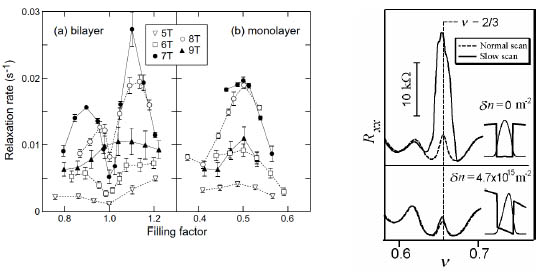Norio Kumada1, Katsushi Hashimoto2*, Koji Muraki1 and Yoshiro Hirayama1
1Physical Science Laboratory, 2SORST-JST
Nuclear magnetic resonance (NMR) is a powerful technique to detect dynamic and static properties of electron spins, and is commonly used not only in physics, but also in chemistry, biology and medicine. For two-dimensional electron systems (2DESs) realized in semiconductor heterostructures, however, a small number of nuclei in contact with the 2DES and the overwhelming background due to the thick substrate have restricted those experiments to multiple layer samples with fixed electron densities. To carry out nuclear spin measurements in a single density-tunable 2DES, we use a specific electronic state in a quantum Hall (QH) system, which allows for the current-induced nuclear spin polarization and, at the same time, facilitates its resistive detection. With this new experimental technique, we can investigate various electronic states. Followings are recent results.
In a bilayer system consisting of two closely separated 2DESs, we investigate
νtot=1 QH state, which can be viewed as a superfluid of interlayer excitons.
Nuclear spin-lattice relaxation rate, which probes electron spin fluctuations,
changes around the bilayer νtot=1 QH state [Fig. 1(a)]. This result demonstrates that, as opposed to common
assumption, the electron spin degree of freedom is not completely frozen
in the QH state [1]. Furthermore, we show that the current-induced nuclear
spin polarization in semiconductor heterostructures is strongly modified
by their potential inversion asymmetry (Fig. 2). This finding strongly
suggests that even a very weak spin-orbit interaction can play a dominant
role in determining the electron-nuclear spin coupling [2].
The experimental technique for the high-sensitive nuclear spin measurement established in this work, and the new findings obtained by using the technique are important for future low-dimensional electric devices.
[1] N. Kumada et al., Phys. Rev. Lett. 94 (2005) 096802.
[2] K. Hashimoto et al., Phys. Rev. Lett. 94 (2005) 146601.
*Present address: Hamburg University
 |
||||||
|
|
|||||